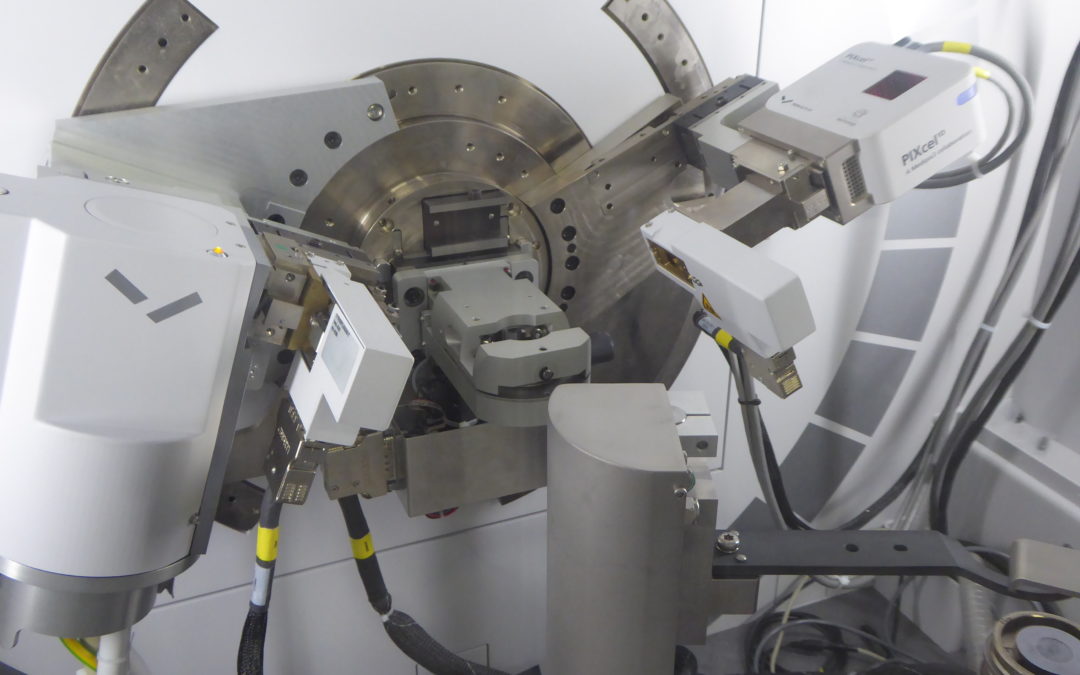The X-ray Diffractometer PANalytical Empyrean is a multipurpose diffractometer that offers a wide range of diffraction geometries: reflection, transmission, capillary, Debye-Scherrer, Graze Incident X-ray Diffraction (GIXRD), Small and Wide Angle Scatering (SAXS & WAXS)… Combining different available sets of optical components and sample stages it has the ability to analyze a wide range of samples such a powders, solid objects, thin films, dispersions… Thanks to the PreFIX concept it is possible to exchange between the operation modes / configurations in few minutes without the need to realign the system. The diffractometer is equipped with PIXcel1D detector. A dedicated strip detector for 0D and 1D applications which allows to measure up to 255 times faster than with a traditional point detector, without compromising data quality.
The laboratory is complemented with the powerful HighScore analysis Software. From phase identification to Rietveld analysis. Using a Full pattern approach HighScore is the ideal software for phase identification, semi-quantitative phase analysis, pattern treatment, profile fitting and more.

AVAILABLE SAMPLE STAGES
- Reflection- Transmission spinner stage with automatic sample changer.
- 3-Axis (chi, Phy, Z) cradle for samples with non-standard geometries, for residual stress and texture analysis and for GIXRD and reflectometry analysis in thin films.
- ScatterX78 module: Versatile tool for nanomaterial analysis to perform small- and wide-angle X-ray scattering (SAXS/WAXS) measurements on nanomaterials. The SAXS signal allows for the dimensional and structural analysis of a material on the nanoscale. Complementary information about the crystalline phases, the size of nanocrystallites and their orientation can be obtained from the WAXS signal. ScatterX78 can be used for the characterization of a variety of samples, such as colloidal dispersions, polymers, protein solutions, surfactants, nanopowders and liquid crystals. The SAXS setup with ScatterX78 allows for measurements of SAXS data from 0.08 deg 2theta up to 78 deg 2theta WAXS.
- HTK 1200N – High temperature oven heater. Anton Paar HTK 1200N is designed for non-ambient powder X-ray diffraction in reflection and transmission geometries with environmental heating of the sample up to 1200 ºC in air, inert atmosphere or vacuum. High temperature uniformity over the entire simple volume due to environmental heating. Accurate temperature measurement with a thermocouple close to the sample heating. In addition to standard reflection geometry a capillary transmission option is available.
- What kind of information can be obtained?
- Sample requirements
- Technical specifications and capabilities
Whether you are interested in improved process control, or doing research and development, understanding your materials starts very often with understanding the powder diffraction pattern. Traditionally X-ray powder diffraction is most widely used for the characterization of unknown crystalline materials. Determination of unknown solids is fundamental material science, engineering, geology, and biology. Nowadays capabilities of XRD include new applications and XRD is useful for a wider range of materials including not only inorganic materials, but also polymers, nanomaterials, dispersions, composites, soft materials, coatings…
Applications
- Qualitative and quantitative phase analysis
- Identification of materials (if crystalline)
- Crystalline Phase identification
- Quantification of mixtures of phases
Crystallographic analysis
- Determination of Lattice parameters / unit cell dimensions
- Determination / Refinement of structure of crystalline materials
Microstructural analysis
- Analysis of textures / preferential orientation such as the orientation of grains, in a polycrystalline sample
- Residual stress and micro-strain
- Determination of grain size in polycrystalline blocks
- Differentiation between crystalline and amorphous materials. Degree of crystallinity.
- Particle size determination
Other applications:
Dimensional and structural characterization of nanomaterials:
- Diffuse scattering: Random nanostructures and nano-objects: size, shape, structure, segregation…
- SAXS: Periodic nanostructures: repeat distances, symmetry, degree of order
- WAXS: Identification and quantification of crystalline phases, degree of crystallinity, Nanocrystallite size…
GIXRD and reflectivity: Characterization of Thin films and multilayers. Stress, thickness, roughness and density. Depth profiles.
Non-ambient XRD: In-situ studies of temperature-induced phase transformations and changes of structural properties (strain, grain size, phase composition, order-disorder transformations, thermal expansion…).
The PANalytical Empyrean diffractometer is capable to manage with a wide range of samples: Inorganics, polymers, nanostructured materials, soft materials… They can be in the form of bulk materials, powders, foils, thin films, gels, liquids, dispersions…
When working with large and heavy samples the 3-axes Empyrean cradle enables analysis of components weighing up to 2 kg. Parallel-beam geometry can be used for the phase identification of rough and irregularly shaped objects.
Different sample holders are available for Transmission and reflection X-ray depending on the available amount of sample and geometry and zero background holders to be used when only small amount of powdered sample is available.
X-RAY Generator / Tube
- Generator: 4kW (max. 60kV and 100mA)
- Tube: Cu Anode (45 kV, 40 mA)
Goniometer
- Radius: 240mm
- Maximum usable range: -111° < 2theta < 168°
- Smallest addressable increment: 0.0001°
- Angular reproducibility: < 0.0002°
- 2theta linearity over whole range Equal or better than +/-0.01°
- Maximum angular speed: 15 deg/s
- Angular resolution (FWHM on LaB6): 0.02°
Incident Beam optics
- Programmable Divergence Slit (PDS)
- Parallel Beam (parabolic) Mirror
- Focusing Beam (elliptical) Mirror
Diffracted Beam optics
- Programmable Anti-Scatter Slit (PASS)
- 0.27º Parallel Plate Collimator (PPC)
Detector: PIXcel1D Medipix3
- 255 detectors of 55 μm x 14 mm (3.3 º2θ)
- Each 99% linear up to 5 Mcps
- Maximum count rate of 50 Mcps
- 0D, 1D scanning and static modes
Reflection Transmission Spinner
- Sample modes (change in omega zero)
- Sample changer
- Sample holders
Back loading on Ø16 and Ø27 mm
Zero Background Holders
Irregular samples: max [mm] Ø44, 6.5 thick
Transmission between foils
HTK 1200N with capillary extension
- Furnace up to 1200 ºC
- Temperature measurement at the sample
- Total integration on DataCollector software. Programmed and Measured temp. Profiles.
- Sample holders
. Ø16 mm (0.4 and 0.8 deep) for reflection
. 1 mm quartz capillaries for transmission
Three-Axes (Z, Phi, Chi) cradle 10
- Axis Chi Phi Z
- Range: -3° to 93° 2 x 360 12mm
- Minimum Step 0.01° 0.01° 1µm
- Reproducibility: ≤0.01° ≤0.01° 1µm
- Speed 2.5°/s 10°/s 2 mm /s
- Samples up to 2 kg
ScatterX78
- The ScatterX78 can be evacuated to eliminate parasitic air scattering.
- The SAXS setup for measurements of SAXS data from 0.08 deg 2theta. Each data set also contains the attenuated direct beam profile as a reference
- WAXS up to 78 deg 2theta
HighScore 4.1 11
- Pattern Treatment: Background, Peaks…
- Phase Identification (COD database)
- Crystallography: indexing, unit cell refinement…
- Fits: Profile, Le Bail, Pawley, Rietveld…
- Structure Solution: Superflip algorithm, Fourier…
- Cluster Analysis
- Partial Least-Squares (PLS) Regression Analysis
- Tools: Bitmap converter, four calculators…
- Automation: Parameter Sets, User Batches,
- New functionality via scripting in Pascal
Laboratorio de Microscopías Avanzadas
We are a unique initiative at national and international levels. We provide the scientific and industrial community with the most advanced infrastructures in Nanofabrication, Local Probe and Electron Microscopies for the observation, characterization, nanopatterning and handling of materials at atomic and molecular scale.
Contact information
Campus Río Ebro, Edificio Edificio I+D+i
Direct Links
© 2021 LMA | Website developed by o10media | Política de privacidad | Aviso legal | Condiciones de uso | Política de Cookies |







